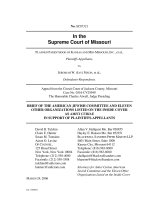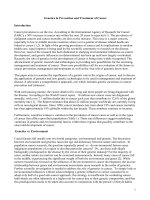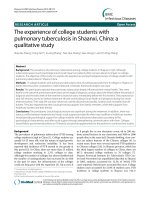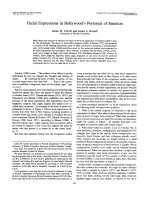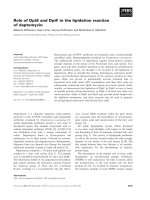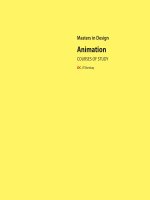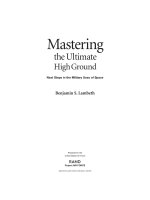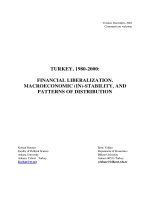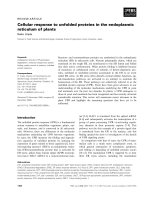Masters in Design Animation Courses of Study ppt
Bạn đang xem bản rút gọn của tài liệu. Xem và tải ngay bản đầy đủ của tài liệu tại đây (233.46 KB, 17 trang )
Masters in Design
Animation
COURSES OF STUDY
IDC, IIT Bombay
2
ANIMATION DESIGN | IDC, IIT Bombay
M.Des in Animation
The Animation program in IDC will strive to create
people with expertise who will eventually emerge
as leaders to inuence the future of Animation. IDC
expects the students to assume direct responsibility
for nearly all aspects of the lm making process.
The students will have access to cutting edge IT
capabilities and the proximity to other engineering
disciplines which would facilitate cross disciplinary and
collaborative projects, also new areas for animation
applications can be explored and experimented with.
The proposed course content includes all areas of
study essential to nurture a well rounded approach to
learning and understanding in the eld of animation.
3
ANIMATION DESIGN | IDC, IIT Bombay
Animation Course Content - Semester 1
Course Number Course Name L T ST Credits
VC 601
Visual Language – Syntactics 0 0 4 6.0
AN 601 Animation Principles and History 1.5 0 2 6.0
AN 603
Animation Process and Visual Form 0 0 4 6.0
VC 609
Art, Design and Society I 2 0 0 4.0
ID 643 Design Issues 2 0 0 4.0
Elective I 6.0
Elective II 6.0
Total Credits for Semester I 38.0
Course Number Course Name L T ST Credits
VC 603
Image Making and Representation I 0 0 4 6.0
VC 605 Photo Communication 0 0 4 6.0
ID 627 Elements of Design 0 0 4 6.0
ID 629 Media Investigation and Communication Methods 0 0 4 6.0
ID 645 Exposure to Design 0 0 4 6.0
ID 667 Design Workshop I 0 0 4 6.0
AN 609
Life Drawing 0 0 4 6.0
Animation Elective Courses - Semester 1
4
ANIMATION DESIGN | IDC, IIT Bombay
AN 601
Animation Principles And History 1.5 0 2 6
Principles
Understanding principles that translate sequential •
images into action to make animation believable
Understanding properties of matter•
Making use of the wave principle, delayed secondary •
action, slow and fast action impact , speed,
weight, tendency of weight to move in a certain
way, recoil eects, squash and stretch related to
weight, overlapping action, follow through
Animating force acting on objects , object •
weight, construction, exibility, object
behaviour when force acts on them
Principles of Timing•
Gaining an insight into the invisible •
concept of time in nature
Understanding the basic unit of time in animation •
Emphasizing the dierence between •
caricature, drama, humour
Timing governing acting and movement •
The use of anticipation, action, reaction •
Methods of doping, writing exposure sheets, bar sheets•
Planning accents, beats, scene timing, spacing •
of drawings, holds, easing in and out
Animating to music•
Principles of Movement •
Understanding the meaning of movement and •
movement in nature and what movement expresses
Awareness of how mood and feeling can be •
conveyed through movement and animate
and inanimate object behaviour
Examining the laws of motion in the context of •
animation; cause and eect, thrown objects, rotating,
force, oscillating movement, friction, resistance
Studying the tendency of weight to •
move in a particular manner
Simplication and exaggeration of movement •
Animation History
To gain an understanding of the evolution of animation•
Delving into animation history- both of India and •
the world.
Precursors to animation: Cave paintings, animation toys•
Animation before Disney•
Studio animation•
Feature animation•
Experimental animation•
Personal lms and expression•
Adult animation•
Animation Today •
References for principles and theory
Harold Whitaker and John Halas, Timing for •
Animation, Focal Press, Oxford, 2002
Preston Blair, Cartoon Animation, Walter •
Foster Publishing Inc., CA, 1995
Edited by Peter Hames, Dark Alchemy, The Films •
of Jan Svankmajer, Greenwood Press, 1995
John Culhane, Disney’s Aladdin – The Making •
of an Animated Film Hyperion, NY, 1992
References for History
Dave Smith, The Ocial Encyclopedia – •
Disney A to Z Hyperion, NY, 1998
Vol : 18, Special Issue of Art History, March 1985•
Leonard Maltin, Of Mice and Magic – A •
History of American Animated Cartoons
Plume, Penguin Books. USA, 1990
Bob Thompson, Disney’s Art of Animation – •
From Mickey Mouse to Hercules Hyperion,
NY, 1997•
Donald Craften, Before Mickey – The Animated •
Film [1898 – 1928], The University of Chicago
Press, 1993 •
Peter Hames (edited by), Dark Alchemy, The Films •
of Jan Svankmajer, Greenwood Press, 1995
John Culhane, Disney’s Aladdin – The Making •
5
ANIMATION DESIGN | IDC, IIT Bombay
of an Animated Film Hyperion, NY, 1992
Alan Cholodenko (edited by), The Illusion of Life- •
Essays on Animation Power Publication in
association with Australian Film Commission, SYD, 1991•
Eric Smoodin (edited by), Routledge, Disney Discourse •
– Producing the Magic Kingdom, London, 1994
Jay Leyda (edited by), Eisnstein on Disney, •
Seagull Books, Calcutta, 1986
Ernest Pinto, Animation 101Michael •
Wiese Productions, CA, 1999
AN 603
Animation Process And Visual Form 0 0 4 6
Animation Processes
Covers the entire process from script to screen in •
process for an animation lm (short or feature)
Overview of the Process•
Preproduction, Production, Post Production•
A comparison between live action lm making & •
animation The primary dierence being that an
animation lm tends to be pegged down pretty
accurately by the end of the preproduction process itself
whereas for a live action lm it is close to completion only
at the end of editing which is a post production process.
Preproduction
Story to Script•
Whether adapted or original, taking the story from a •
verbal or spatial medium like a book or graphic novel to a
form suitable for making a lm. What makes a good story?
Plot & Character: Action Plots & Mind Plots. •
Analysis of dierent types of plots
Archetypes v/s Stereotypes - understanding •
of archetypes and a brief introduction to
the mono myth (hero’s journey).
Why Animation? (instead of live action) •
Animation as a story telling (narrative) medium •
Animation as an artistic medium•
Visual Concepts, Character Exploration & Storyboards•
Animatics•
Character Design & Model Sheets, •
Layouts & Scene Planning
Production
Animation•
Acting - Animation is not about moving •
images but moving people
Traditional 2D anim•
a. Linetests - Keyframes & Timing (breakdowns •
& inbetweens) also brief introduction to
thumbnailing (for quick exploration of
alternative methods of animating a scene)
Study comparisons between dierent •
rhythms of animation
Executing straight ahead and inbetweened planned •
animation, limited animation full animation
Drawing key frames, breakdowns, •
inbetweens, animation cycles
Cleanups•
Post Production
Voice, Music & Eects•
Understanding the dynamics of sound design and •
use of sound as a key component of animation
Designing a sound track for animation including •
music, dialogue, voice overs, lip synch and FX
Recording and mixing multiple tracks•
Post processing sound•
Compositing & Editing•
Work in Progress. Development of a lm from Animatic •
to Edit with dierent scenes at dierent stages.
Coming together of the various elements of the scene. •
Final Mixing of Sound & Final Edit•
Understanding the dynamics of camera •
moves and magnications
Experimenting with camera techniques •
6
ANIMATION DESIGN | IDC, IIT Bombay
and working directly under camera
- Using registration elds, table •
moves and peg movements
Screening & Feedback•
Pitching a Project, Financing, Production & Distribution•
Visual Form
Exploring the look and feel for •
animation through concept art
Planning character design, layout design, illustration •
style, composition, staging, backgrounds
A study of indigenous design and painting, both •
contemporary and traditional to understand and
analyze a variety of styles and visual language
References for processes
Shamus Culhane, Animation from script to •
screen, St.Martin’s Grin Press, NY, 1990
Richard William, The Animators Survival Kit, •
Faber and Faber, New York, London, 2002
Kit Laybourne, The Animation Book, •
Crown Trade Paperbacks, NY, 1998
Tony White, The Animator’s Workbook- Step •
by Step Technique of Drawn Animation,
Watson-Guptill Pulications, 1988
Mascelli Joseph V, The Five C’s of •
Cinematography: Motion Pictures Filming
Techniques, Silman-James Press, 1998
Daniel Arijon, Film Technique, Silman-James Press, 1991 •
David Sonnensch, Sound Design: The Expressive •
Power of Music, Voice and Sound Eects in
Cinema, Michael Wiese Productions, 2001
David Lewis Yewdall, Practical Art of Motion Picture •
Sound, Second Edition, Focal Press, 2003
Tomlinson Holman, Sound for Film and •
Television, Second Edition, Focal Press, 2001
References for Visual Form
Mark Cotta Vaz, The Art of Finding •
Nemo, Cronicle Books, 2003
Gary Russell, The Art of The Fellowship of •
the Rings, Houghton Miin, 2002
Gary Russell, The Art of The Two Towers (The •
Lord of the Rings), Houghton Miin, 2003
Gary Russell, The Art of The Return of the King •
(The Lord of the Rings), Houghton Miin, 2004
Will Eisner, Graphic Storytelling, Poorhouse Press, 1996•
Will Eisner, Comics and Sequential •
Art, Poorhouse Press, 1985
Scott McCloud, Understanding Comics, •
Perennial Currents, 1994
Bradford W. Wright, Comic Book Nation, •
Johns Hopkins University Press, 2003
Stephen Missal, Exploring Drawing for •
Animation (Design Exploration Series),
Thomson Delmar Learning, 2003•
AN 609
Life Drawing 0 0 4 6
To become uent with capturing the •
human and animal form
Proportions, structure, volume and shading techniques•
References
John.V.Vanderpoel, The Human Figure, •
Dover Publication Inc., NY, 1958
George.B.Bridgman, Bridgman’s Life, Drawing •
Dover Publication Inc., NY, 197
Betty Edwards, The New, Drawing on the Right Side •
of the Brain, Harper Collins Publishers, 2001
Betty Edwards, The New, Drawing on the Right Side of •
the Brain, Workbook Souvenir Press Ltd., London, 2002
Stephen Missal, Exploring Drawing for Animation •
(Design Exploration Series), (Paperback)
Thomson Delmar Learning, 2003
7
ANIMATION DESIGN | IDC, IIT Bombay
Course Number Course Name L T ST Credits
AN 602
Animation Design and Theory 1.5 0 2 6.0
AN 604
Animation Scripting and Methods 0 0 4 6.0
VC 654
Semantics and Communications Theory 1.5 0 2 6.0
VC 614
Art, Design and Society II 2 0 0 4.0
AN 605 Computers for Animation Audit
Elective III 6.0
Elective IV 6.0
Total Credits for Semester I 34.0
Animation Course Content - Semester 2
8
ANIMATION DESIGN | IDC, IIT Bombay
Animation Elective Courses - Semester 2
Course Number Course Name L T ST Credits
VC 602
Image Making and Representation II 0 0 4 6.0
VC 604
Digital Video Communication 0 0 4 6.0
VC 618 Information Graphics 0 0 4 6.0
VC 620
Advanced Typography 0 0 4 6.0
VC 624
Designing Interactive Experiences 0 0 4 6.0
VC 626
Story and Narrative 1.5 0 2 6.0
ID 634 Sketching for Designers 0 0 4 6.0
ID 638 Product Interface Design 0 0 4 6.0
IN 604
Usability Evaluation 1.5 0 2 6.0
IN 612 Interactive Media 0 0 4 6.0
IN 614
Soft Prototyping Techniques 0 0 4 6.0
AN 608
Anatomy and Drawing 0 0 4 6.0
ID 668 Design Workshop II 0 0 4 6.0
Institute Elective 6.0
Institute Elective 6.0
9
ANIMATION DESIGN | IDC, IIT Bombay
AN 602
Animation Design and Theory 0 0 4 6
Study of Animation Techniques & styles developed •
and used over the years in animation.
Appreciating the dierence between the processes •
of the basic 3 methods of animation, namely
frame by frame creation of animation (like traditional 2D) •
modication of object or image to produce •
animation. (like paint on glass, sand on glass,
simple claymation without armatures etc)
manipulation of objects to produce animation. •
(like 2D cutout animation, 3D claymation with
armatures, simple object animation, Puppets, etc)
Exploring & developing the animation world based •
on the technique you might choose for animation.
The Digital World and the avenues opened •
by it in terms of animation design.
Animation articulation and performance
Understanding the role of drama and acting in •
creating convincing characterization and emotion
Creating believability by taking o on the •
natural, making objects behave in character
Expressing attitude, gesture, body language•
Role playing through actual and mental miming •
Character acting, reacting, take•
Expressing exaggeration through caricatured •
matter acted upon by caricatured forces
Character Animation
Reecting on human movement•
Gaining an insight into creating believable action •
Practicing the mechanics of biped •
walks, runs, head turns, gestures
Methods of lip-syncing to sound breakdowns •
Posing characters in scenes•
Animal movement
Reecting on animal movement•
Gaining an insight into creating believable action•
Practicing the mechanics of quadraped- walks, •
runs, gallops; bird movement and ight
Sfx
An awareness of and an ability to •
create convincing atmosphere
Creating animated environments and •
atmosphere like ames, smoke, water, rain,
snow etc. to oset principal animation
Creating Special eects such as •
explosions, speed lines etc.
Theory
Understanding contemporary trends in •
animation making in terms of content,
styling, techniques and applications
Studying animation lms through lm viewing, •
appreciation, criticism, theoretical
writings, essays , research studies
Aesthetics: Introduction to Aesthetics •
(Indian and Western)
Introduction to major art movements•
Narrative: Introduction to narrative •
structures (Indian and Western)
Modes of Narrative•
Narrative Discourse•
Film Theory: Perception•
Representation•
Signication•
Genres•
Identication and Psychoanalysis•
Interpretation•
References:
Ed Hooks, Acting for Animators •
Heinemann, Reed Elsevier, 2000
10
ANIMATION DESIGN | IDC, IIT Bombay
Eadweard Muybridg, The Human Figure in •
Motion, Dover Publication Inc., NY, 1995
Richard William, The Animators Survival Kit, •
Faber and Faber, New York, London, 2002
David Choquet, 1000 Game Heroes, Taschen. 2002•
Eadweard Muybridg, Animals in Motion, •
Dover Publication Inc., NY, 1957
Alan Cholodenko (edited by), The Illusion of Life- •
Essays on Animation Power, Publication in association
with Australian Film Commission, SYD, 1991
Eric Smoodin (edited by), Disney Discourse – Producing •
the Magic Kingdom Routledge, London, 1994
Jay Leyda (edited by), Eisnstein on Disney •
Seagull Books, Calcutta, 1986
Ernest Pinto, Animation 101, Michael •
Wiese Productions, CA, 1999
AN 604
Animation Scripting and Methods 0 0 4 6
Experimenting with techniques for visual storytelling, •
structure, story building, writing for animation
Examining indigenous narratives, both contemporary •
and traditional to gain an understanding of
storytelling methods pertinent to our culture
Creating dramatic ow, planning, pacing, sequencing, •
organizing visual ow and continuity in storyboards
Co-ordinating character, scene length, pace of action•
Choreographing scene change and camera movement•
Planning, examining, analyzing and •
pacing character behaviour
An exposure to various animation techniques•
Workshops using both 2D and 3D techniques •
on Computer, Film, Video etc.
Production of professional stop-motion •
animation puppet and usable set props.
Understanding how a stop-motion •
animation production works
Sculpting, mould making, armature •
construction and casting techniques.
Methods to fabricate a stop-motion animation puppet •
Techniques for set construction.•
Doping, animating, lighting and shooting •
Post production techniques•
References for Methods
Robert Russett and Cecile Starr, Experimental Animation, •
Origins of a New Art A Da Capo Paperback, NY, 1998
Peter Lord and Brian Sibley, Cracking Animation –The •
Aardman book of 3D Animation, Thames & Hudson, 2000
Richard Taylor, Encyclopedia of Animation •
Techniques, Book Sales, 2004
Michael Frierson, Clay Animation: American Highlights •
1908 to Present, Twayne Publishers, 1994
Chris Patmore; The Complete Animation Course: The •
Principles, Practice, and Techniques of Successful
Animation, Barron’s Educational Series, 2003
Frank Thompson, The Making of The Nightmare •
Before Christmas, Disney Editions, 2002
Peter Lord and Brian Sibley, Cracking Animation –The •
Aardman book of 3D Animation, Thames & Hudson, 2000
References for scripting
Marilyn Webber, Gardner’s Guide to Feature •
Animation Writing: The Writer’s Road Map
Garth Gardner Company, 2002
Jerey Scott, How to Write for •
Animation, Overlook Press, 2002
Marilyn Webber, Gardner’s Guide to Animation •
Scriptwriting: The Writer’s Road Map,
Garth Gardner Company, 2002•
Jean Ann Wright, Animation Writing and •
Development: From Script Development to Pitch
(Focal Press Visual Eects and •
Animation), Focal Press, 2005
11
ANIMATION DESIGN | IDC, IIT Bombay
AN 605
Computers for Animation Audit
To enlarge the repertoire of tools to create animation•
An experience of working across varied •
Animation Software like Maya, Animo,
3D Studio Max, Flash etc.•
References
Dan Ablan, Digital Cinematography & •
Directing, New Riders Press, 2002
Jeremy Birn, Digital Lighting & Rendering, •
New Riders Press, 2000
Owen Demers, Digital Texturing & •
Painting, New Riders Press, 2001
Glenn Kirkpatrick, Flash Cartoon Animation: Learn •
from the Pros, A-Press, 2003
AN 606
Animation Theory 0 0 4 6
Understanding contemporary trends in animation making •
in terms of content, styling, techniques and applications
Studying animation lms through lm •
viewing, appreciation, criticism, theoretical
writings, essays , research studies
Aesthetics: Introduction to Aesthetics (Indian and Western)•
Introduction to major art movements•
Narrative: Introduction to narrative •
structures (Indian and Western)
Modes of Narrative•
Narrative Discourse•
Film Theory: Perception•
Representation•
Signication•
Genres•
Identication and Psychoanalysis•
Interpretation•
References:
Dark Alchemy, The Films of Jan Svankmajer •
Edited by Peter Hames, Greenwood Press 1995•
Disney’s Aladdin – The Making of an Animated Film •
John Culhane, Hyperion, NY, 1992•
The Illusion of Life- Essays on Animation •
Edited by Alan Cholodenko, Power Publication in •
association with Australian Film Commission, SYD, 1991
Disney Discourse – Producing the Magic Kingdom •
Edited by Eric Smoodin, Routledge, London, 1994•
Eisnstein on Disney •
Edited by Jay Leyda, Seagull Books, Calcutta•
Animation 101•
Ernest Pinto, Michael Wiese Productions, CA, 1999•
AN 608
Anatomy and Drawing 0 0 4 6
Understanding of the relationship of bones and •
muscles at rest and in movement to be able to translate
this to creating and maintaining correct volumes
Studying human and animal movement through •
sequential drawings, gesture drawing
References
Victor Perard, Anatomy and Drawing, •
Dover Publications Inc., NY, 2004
Steve Roberts, Character Animation in 3D: Use •
traditional drawing techniques to produce
stunning CGI animation, Focal Press, 2004
Christopher Hart, Drawing Cutting Edge •
Anatomy: The Ultimate Reference for Comic,
Watson-Guptill Book Artists Publications, 2004•
Eadweard MuybridgE, Animals in Motion, •
Dover Publication Inc., NY, 1957
Eadweard MuybridgE, The Human Figure in •
Motion, Dover Publication Inc., NY, 1995
12
ANIMATION DESIGN | IDC, IIT Bombay
Course Number Course Name L T ST Credits
AN 610
Sound and Camera 0 0 4 6.0
VC 615
Indian Thoughts and Traditions 2 0 0 4.0
Elective V 6.0
Elective VI 6.0
ANP 601
Summer Project 1 ( Mid May - Mid June) 6.0
ANP 602
Design Project 2 (Mid June - End November) 18.0
Total Credits for Semester III 46.0
Animation Course Content - Semester 3
13
ANIMATION DESIGN | IDC, IIT Bombay
Course Number Course Name L T ST Credits
VC 627
Advanced Digital Video Communications 0 0 4 6.0
VC 619 Advanced Photography 0 0 4 6.0
VC 635
Studies in Human Computer Interaction 0 0 4 6.0
VC 637
Experimental Animation 0 0 4 6.0
VC 667 Visual Culture 1.5 0 2 6.0
ID 639 Design Management and Professional Practice 1.5 0 2 6.0
ID 653 Product Detailing 0 0 4 6.0
ID 657 Advanced Ergonomics 0 0 4 6.0
ID 659 Product Semantics 0 0 4 6.0
ID 665 Craft, Creativity and Post-Modernism 0 0 4 6.0
ID 669 Design Workshop III 0 0 4 6.0
ID 675 Designing Game for Children 0 0 4 6.0
IN 653
Instructional Design 1.5 0 2 6.0
AN 611
Representation Methods for Animation 0 0 4 6.0
Institute Elective 6.0
Animation Elective Course Content - Semester 3
14
ANIMATION DESIGN | IDC, IIT Bombay
AN 610
Sound and Camera 0 0 4 6
Understanding the dynamics of sound •
design and use of sound as a key
component of animation•
Designing a sound track for animation including •
music, dialogue, voice overs, lip synch and FX
Recording and mixing multiple tracks•
Post processing sound•
Understanding the dynamics of camera •
moves and magnications
Experimenting with camera techniques •
and working directly under camera
Using registration elds, table moves •
and peg movements
References
Mascelli Joseph V, The Five C’s of •
Cinematography: Motion Pictures Filming
Techniques, Silman-James Press, 1998
Daniel Arijon, Film Technique, Silman-James Press, 1991 •
David Sonnensch, Sound Design: The Expressive •
Power of Music, Voice and Sound Eects in
Cinema, Michael Wiese Productions, 2001
David Lewis Yewdall, Practical Art of Motion Picture •
Sound, Second Edition Focal Press, 2003
Tomlinson Holman, Sound for Film and •
Television, Second Edition Focal Press, 2001
AN 611
Representation Techniques For Animation 0 0 4 6
Dierent techniques of representations for animation.•
Experiment with dierent methods of representation•
Exploring dierent skills, tools and •
medias to represent for animation.
References
George.B.Bridgman, The Book of a Hundred •
Hands, Dover Publication Inc., NY, 1972
Richard Taylor , Encyclopedia of Animation •
Techniques, Book Sales, 2004
Robert Russett, Experimental Animation: Origins •
of a New Art Cecile Starr (Editor), Capo, 1988
Alan Watt, M. Advanced Animation and Rendering •
Techniques Watt, Addison-Wesley Professional, 1992
AN 613
Animation Technology 0 0 4 6
An exposure to the latest that technology has to oer •
when it comes to applications in the led of animation.
Student will be kept abreast with innovative and •
ground breaking techniques adapted/invented
which have pioneered the process of animation.
Simulation (Environments etc.)•
Crowd Control•
MOCAP (Motion Capture)•
VR (Virtual-reality)•
Rendering Technologies•
Digital Lighting•
Compositing Techniques•
Eects - reections, refractions, global •
illumination and caustics.
Motion Building•
Alternative Modelling Methods – eg.: Luxology Modo, •
CLOTHFX•
Studio visits•
15
ANIMATION DESIGN | IDC, IIT Bombay
ANP 601
Summer Project I 6 Credits
(Mid June to mid July)
This is a summer project that can be done with an
industry, professional design rm, an institution or
an organisation like an NGO. The objective of this
project is to be part of the process where design is
being implemented, contribute towards the process
and learn from the situation. The project is meant
to expose the student to design practices in his
chosen area of interest. This project is expected
to inuence the degree project in many cases.
ANP 602
Design Project II 18 Credits
(Mid July to November end)
An independent project with one of the following focus:•
Design project of student interest and / or •
faculty interest and / or industry project
Re-design project that relooks at an •
existing problem or situation
Research project, delving into •
methodological or pedagogic issues
Exploration project, exploring application possibilities •
in a new technology or medium or variations
16
ANIMATION DESIGN | IDC, IIT Bombay
Course Number Course Name L T ST Credits
AN 614
Design Research-Seminar 0 0 4 6.0
ANP 603
Design Project III – Stage 1 (from December 1st – end February) 12.0
ANP 604
Design Project III – Stage 2 (from March – April /June) 24.0
Total Credits for Semester IV 42.0
Total Credits for M Des. programme in Animation 160.0
Animation Course Content - Semester 4
17
ANIMATION DESIGN | IDC, IIT Bombay
AN 614
Design Research-Seminar 0 0 4 6
The course involves student researching in an area •
related to design and is expected to produce an
insightful report or a paper on the topic. Students
need to choose a topic suggested by a faculty member
and work under faculty guidance. The work may
involve primary and secondary research, creative
exploration out alternatives, experimental set-ups and
methodical documentation. Students are encouraged
to explore new elds, materials and media, with a
focus on analysis. The student is required to present
a seminar on the topic at the end of the semester.
ANP 603
Design Project III Stage1 12 Credits
Duration: 3 months from December – end of February. •
This project could be an extension of the previous •
project (if the scope of the project justies
the extension) or it could be an independent
project with one of the following focus:
Design project of student interest and / or •
faculty interest and / or industry project
Re-design project that relooks at an •
existing problem or situation
Research project, delving into •
methodological or pedagogic issues
Exploration project, exploring application possibilities •
in a new technology or medium or variations.
The evaluation of the Stage 1 of Project II is done •
internally with a panel appointed by the DPGC in
consultation with the guide. The panel will consist
of the guide and two other faculty members.
ANP 604
Design Project III Stage 2 24 Credits
Duration: 2-4 months from March – end June. •
This project will be an extension of the project II •
and should include development of the nal design
concept. The defence presentations will be held
during the month of April and time given till the
end of June to complete the jury feedback, nal
drawings and ner detailing of the project
The evaluation of the Stage 2 of Project II is done •
by a panel of examiners appointed by DPGC. The
panel will consist of external jury member along
with an internal examiner, the guide and the
chairman (A Professor or an Associate Professor
from another Department of IIT Bombay)

